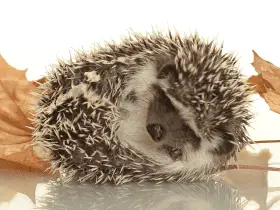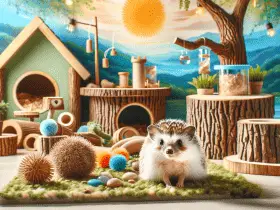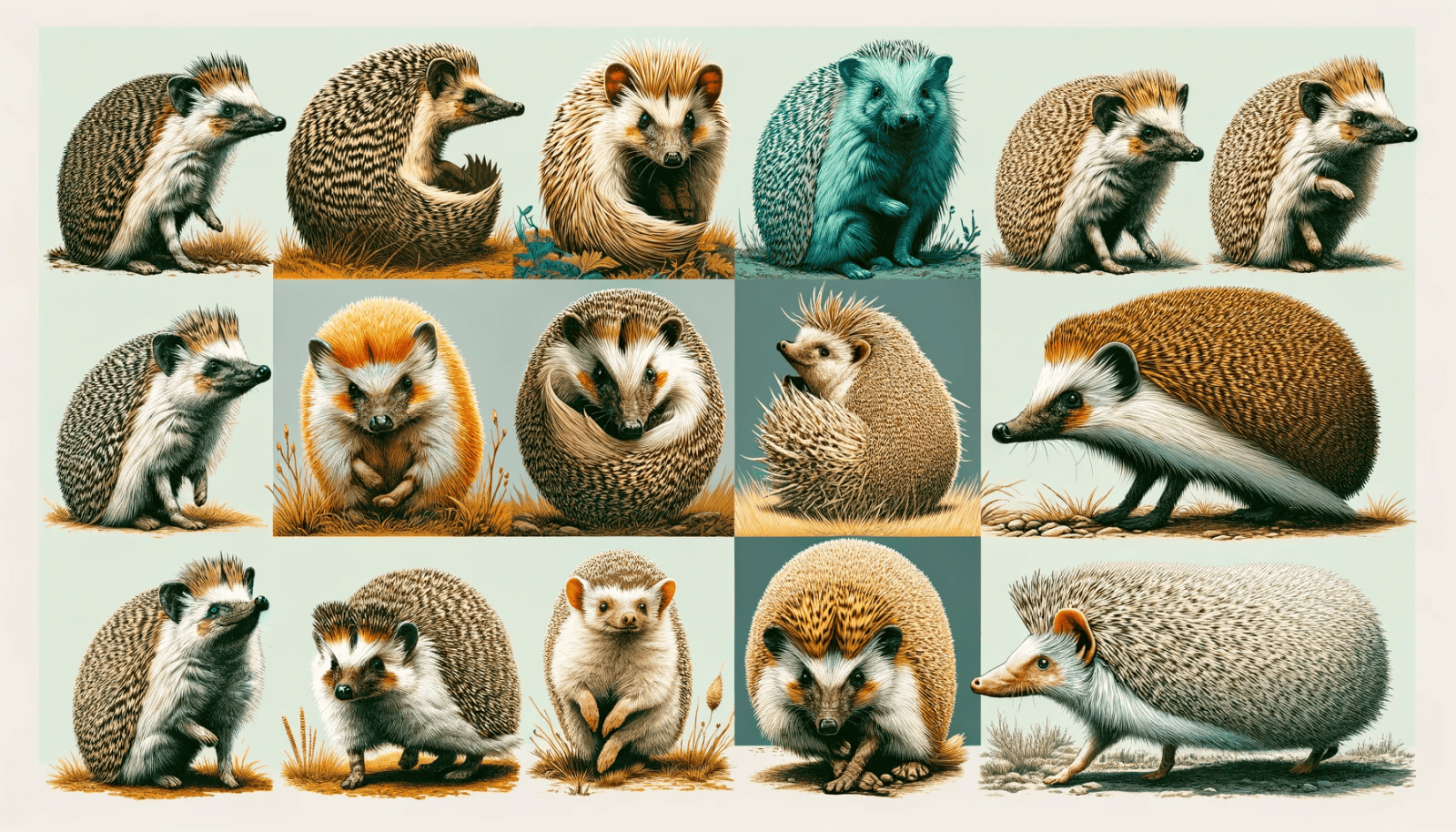Do you ever wonder about hedgehogs? These small, spiky creatures have captured the hearts of people all around the world. From their diverse species to their unique habitats, hedgehogs offer a fascinating glimpse into the wonders of nature.
In this article, we will take a global perspective and compare hedgehog facts from different corners of the globe. Get ready to discover the amazing variations in their diet, reproduction, and cultural significance.
So, let’s dive in and explore the captivating world of hedgehogs together!
Key Takeaways
- Hedgehogs have a long evolutionary history, with the earliest fossils dating back around 15 million years.
- Hedgehog species have unique characteristics and adaptations based on their habitat and region.
- Hedgehogs can be found in woodlands, urban areas, grasslands, and farmlands.
- Hedgehogs are facing population decline due to habitat loss, road accidents, and pesticide use.
Hedgehog Species Diversity
You’ll find hedgehog species diversity in various regions across the world. These fascinating creatures have a long evolutionary history, with the earliest hedgehog fossils dating back around 15 million years. Over time, they’ve adapted to different environments, resulting in a wide range of species with unique characteristics.
In Europe, the most common hedgehog species is the European hedgehog (Erinaceus europaeus). They’re known for their spiky appearance and nocturnal behavior. European hedgehogs have a strong sense of smell and are excellent climbers. They’re also skilled at digging, using their sharp claws to create burrows for protection and hibernation.
In Africa, the African pygmy hedgehog (Atelerix albiventris) is a popular pet species. Unlike its European counterpart, the African pygmy hedgehog is smaller in size and has a more docile temperament. They’re primarily insectivorous, feeding on a variety of insects and invertebrates.
In Asia, the long-eared hedgehog (Hemiechinus auritus) is found in countries such as China and Mongolia. As the name suggests, they’ve long ears that help them detect prey and predators. These hedgehogs are also known for their ability to roll into a ball as a defense mechanism.
Hedgehog Habitat Variations
In different regions across the globe, hedgehogs can be found in a variety of habitats. Understanding the variations in hedgehog habitats is crucial in order to comprehend their adaptations and population trends.
Here are four interesting insights into hedgehog habitat variations:
Woodlands: Hedgehogs are commonly found in woodlands, where they can take advantage of the dense vegetation and leaf litter for protection and foraging.
Urban areas: Hedgehogs have adapted well to urban environments, making use of parks, gardens, and even city outskirts. They can find shelter in gardens, under sheds, and in parks with plenty of vegetation.
Grasslands: Hedgehogs thrive in grassland habitats, where they can hide in tall grasses and feed on insects and small invertebrates that are abundant in these areas.
Farmlands: Hedgehogs are also found in agricultural landscapes, such as farmlands. They can utilize hedgerows and field margins for shelter and feeding, as these areas provide cover and a rich food source.
Understanding the different habitats where hedgehogs thrive is essential for their conservation and management. As human activities continue to impact the environment, it’s important to protect and preserve the diverse habitats that hedgehogs rely on. By doing so, we can ensure the continued presence of these fascinating creatures and contribute to their population trends.
Hedgehog Diet and Feeding Habits
Your hedgehog’s diet and feeding habits are crucial to its overall health and well-being. Hedgehogs are omnivorous creatures with unique foraging behavior. In the wild, hedgehogs primarily feed on insects, such as beetles, worms, and caterpillars. They also consume small vertebrates like frogs and mice. However, hedgehogs in captivity require a balanced diet that meets their nutritional requirements.
A hedgehog’s nutritional requirements consist of a mix of protein, fat, and fiber. They need a high-quality commercial hedgehog food that’s specifically formulated to meet their dietary needs. This food should contain around 25-35% protein, 10-15% fat, and 10-15% fiber. It’s important to choose a food that doesn’t contain any artificial additives or preservatives.
In addition to commercial hedgehog food, you can also supplement their diet with small amounts of fruits, vegetables, and insects. Fruits like apples, bananas, and berries can be offered as occasional treats. Leafy greens and vegetables, such as spinach, carrots, and peas, can be provided in small quantities. Insects like mealworms and crickets can be given as a source of protein.
It is important to monitor your hedgehog’s weight and adjust their diet accordingly. Overfeeding can lead to obesity and other health issues, while underfeeding can result in malnutrition. Always ensure that fresh water is available for your hedgehog to stay hydrated.
Hedgehog Reproduction and Life Cycle
To understand the hedgehog reproduction and life cycle, you should know that hedgehogs are fascinating creatures with unique breeding habits. Here are some key facts about hedgehog mating behavior and the hedgehog gestation period:
Mating Behavior: Hedgehogs are known for their solitary nature, but during the breeding season, males actively seek out females for mating. This usually occurs between April and September, depending on the species and location. Males will perform a courtship ritual, which involves circling and sniffing the female, before attempting to mate.
Gestation Period: After successful mating, female hedgehogs undergo a gestation period that lasts around 35 to 58 days. During this time, the female will build a nest using leaves, grass, and other materials to create a warm and safe environment for her young. It’s important to note that hedgehogs are capable of delayed implantation, meaning the embryo doesn’t immediately attach to the uterine wall, allowing for more favorable conditions for pregnancy.
Birth and Development: Female hedgehogs give birth to a litter of 1 to 7 hoglets, with an average of 4 to 5. The hoglets are born blind, hairless, and completely dependent on their mother for survival. They’ll remain in the nest for the first few weeks, nursing on their mother’s milk and gradually developing their spines and fur. Around 4 to 6 weeks old, the hoglets will start exploring their surroundings and learning to forage for food.
Parental Care: Female hedgehogs are solely responsible for caring for their young. They provide warmth, protection, and milk until the hoglets are old enough to venture out on their own. Once the hoglets reach 6 to 8 weeks of age, they’re weaned off their mother’s milk and begin to fend for themselves.
Understanding the reproductive behavior and life cycle of hedgehogs is essential for those who wish to care for these unique creatures. By respecting their natural breeding habits and providing a suitable environment, we can help ensure the survival of hedgehog populations around the world.
Hedgehog Conservation Efforts
By actively participating in hedgehog conservation efforts, you can contribute to the protection and preservation of these adorable creatures. Hedgehogs are facing a significant population decline in many parts of the world, primarily due to habitat loss, road accidents, and the use of pesticides. To combat this decline, various hedgehog conservation initiatives have been established globally.
One such initiative is the creation and maintenance of hedgehog-friendly habitats. This involves providing suitable nesting sites, such as log piles and hedgerows, as well as ensuring access to food and water sources. Additionally, efforts are being made to raise awareness among the general public about the importance of hedgehogs and the actions they can take to help protect them.
Another key aspect of hedgehog conservation is the rescue and rehabilitation of injured or orphaned hedgehogs. Many organizations work tirelessly to provide medical treatment, care, and release for these hedgehogs back into the wild. They also conduct research to better understand the factors contributing to hedgehog population decline and implement measures to mitigate them.
Furthermore, there are initiatives to monitor hedgehog populations through citizen science programs. These programs involve individuals reporting hedgehog sightings and collecting data on their behavior and distribution. This data is invaluable in assessing the health of hedgehog populations and determining appropriate conservation strategies.
Hedgehog Folklore and Cultural Significance
While hedgehogs may seem like ordinary creatures, they hold a special place in folklore and have cultural significance in many parts of the world. Here are four fascinating facts about hedgehogs in mythology and their symbolic meaning:
Hedgehogs in Mythology: In ancient Greek mythology, the hedgehog was associated with the god Apollo. It was believed that hedgehogs had the ability to predict the future and were considered sacred creatures. In Norse mythology, the hedgehog played a role in protecting the god Baldr, symbolizing defense and resilience.
Symbol of Protection: Hedgehogs have long been seen as protectors in various cultures. Their spiky quills act as a natural defense mechanism, making them a symbol of self-defense and protection against harm. In some cultures, hedgehog symbols were used to ward off evil spirits and bring good luck.
Wisdom and Resourcefulness: Hedgehogs are known for their resourcefulness and ability to adapt to different environments. In some folklore, they’re seen as wise and cunning creatures, representing intelligence and quick thinking.
Symbol of Transformation: In certain cultures, the hedgehog is seen as a symbol of transformation and rebirth. This is due to their ability to roll into a ball and seemingly disappear, only to emerge again unharmed. This trait has led them to be associated with renewal and new beginnings.
Frequently Asked Questions
Are Hedgehogs Native to All Continents?
Hedgehogs are not native to all continents. They play a vital role in different ecosystems worldwide and are subject to conservation efforts. Understanding their global distribution is crucial for effective conservation and ecosystem management.
How Do Hedgehogs Defend Themselves From Predators?
Hedgehogs defend themselves from predators by using their spines as natural defenses. When threatened, they curl up into a tight ball, making it difficult for predators to attack. They also have camouflage techniques, blending into their surroundings to avoid being seen.
Can Hedgehogs Be Kept as Pets?
Hedgehogs can be kept as pets, but it’s important to provide them with a proper diet and a hedgehog-friendly habitat. They require a balanced diet of insects, fruits, and vegetables, along with a spacious enclosure with hiding spots and exercise opportunities.
What Is the Average Lifespan of a Hedgehog in the Wild?
In the wild, a hedgehog’s average lifespan is influenced by various factors. Comparing the average lifespans of wild hedgehogs in different regions provides insight into their adaptability and survival strategies.
Are There Any Famous Hedgehog Characters in Literature or Movies?
There are several famous hedgehog characters in literature and movies, such as Sonic the Hedgehog and Mrs. Tiggy-Winkle. These characters have helped raise awareness about hedgehogs and their conservation efforts.
Conclusion
In conclusion, the comparison of hedgehog facts from around the world reveals the fascinating diversity in species, habitats, diets, and reproductive patterns.
These prickly creatures aren’t only important for the balance of ecosystems but also hold cultural significance in various societies.
The efforts towards hedgehog conservation are crucial in ensuring their survival and maintaining their role in the natural world.
By appreciating these unique creatures and supporting conservation initiatives, we can contribute to the preservation of hedgehog populations globally.















Leave a Reply
View Comments